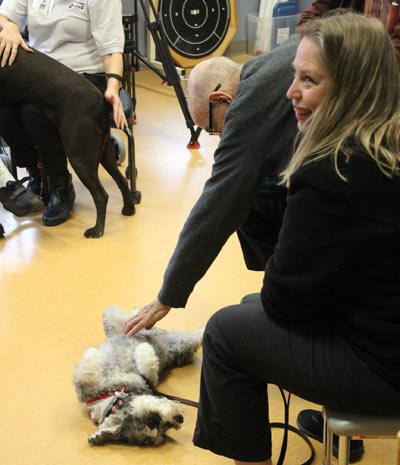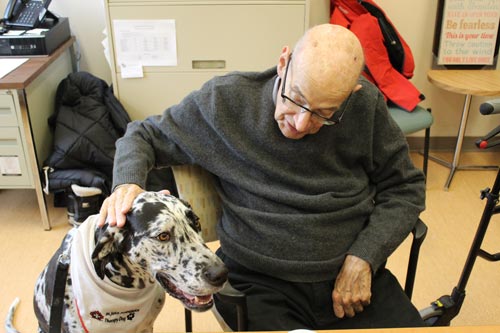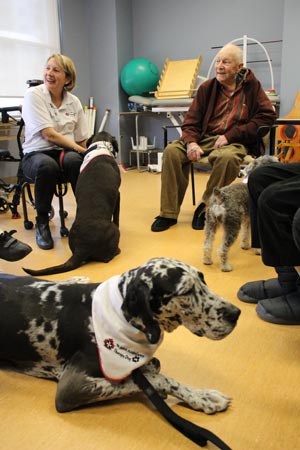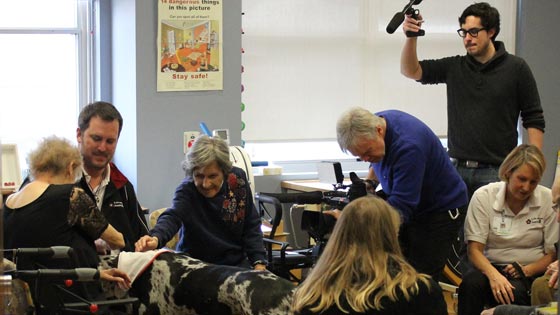
Snickers the therapy dog enjoys a belly rub from an inpatient at Toronto Rehab’s Geriatric Unit. (Photo: UHN News)
Every Thursday is 'Snickers Day' on the Geriatric Inpatient Unit at Toronto Rehab's University Centre.
Snickers, a grey Schnoodle who volunteers as a therapy dog, loves nothing more than to visit patients with her handler, Kathy McPherson. Through the St. John Ambulance Therapy Dog Program, the duo volunteers an hour a week – every Thursday – at Toronto Rehab.
"People's faces absolutely light up when they see Snickers," Kathy says. "It's so rewarding to see how we're helping brighten people's days."
Related to this story:
Pet Therapy at Toronto Rehab
Dogs and their owners who wish to become therapy dog volunteers are vetted through the St. John Ambulance Therapy Dog Program. Though the dogs aren't specially trained to be therapy dogs, they are selected for their natural calmness and friendliness, says Kathy McPherson, who's volunteered with her dog, Snickers for about three years.
The selected dogs and owners are taken through a series of steps to ensure they will do well in healthcare situations. At UHN, the handlers must go through
UHN Volunteer Resources' processes as well to qualify as official UHN volunteers before they can visit any units.
Visit their website for more information about the St. John Ambulance Therapy Dog Program
.
Snickers is just one of the visiting therapy dogs that comes to Toronto Rehab and the University Health Network as a whole, says Tracey Dion, Recreation Therapist for
Geriatric Rehab at TR. Through the visiting pups, patients can find emotional support, pain relief and assistance with their physical rehabilitation.
"Therapeutic Recreation has always included Pet Therapy into their program offerings to different patients in all kinds of settings - whether it's in rehab, long-term care, or mental health," she explains. Right now at Toronto Rehab the program is offered at UC, Bickle Centre and the Lyndhurst Centre.
"Often, the pet is a trigger for a conversation," Tracey says. As the patient pats the dog, they relax and are able to talk about how they're doing, or reflect on memories of their past pets that they're eager to share.
"I love bringing joy to people and actually being able to talk to them about their home life and their pets," says Joanne Somers, a volunteer with St. John Ambulance who visits mental health patients with her dog Lucy. "My number one question is, 'Did you have any pets growing up?' Then they start really thinking about their pets and we can talk about it."

David Campbell, a patient at Toronto Rehab, gives Harlow the therapy dog a head scratch. (Photo: UHN News)
For patients, it's a great visit, says David Campbell, a geriatric inpatient at Toronto Rehab. At 74, he's had four dogs of his own and has enjoyed visiting with the therapy dogs at Toronto Rehab.
"Dogs are a good pal for everyone – they seem to know you and understand you. Like if you're limping, a dog knows to slow down and compensate for you," he says. "They're good friends."
A bridge between different disciplines
Therapy dogs like Snickers, Lucy and Harlow provide more than just emotional comfort, Tracey explains. They can also provide non-pharmacological pain relief for patients, and a way to bridge multiple therapies at Toronto Rehab.
"Through Pet Therapy in therapeutic recreation, patients are able to work on goals in their other disciplines like Occupational Therapy or Physiotherapy," Tracey says.
For instance, if she knows a patient on the unit has had a stroke and is experiencing weakness on one side, Tracey will ask the patient to pat Snickers with that arm in order to practice movement. Or, if a patient is working with Speech Therapy, she'll ask them to practice their speech exercises by talking to the dog.
"I listen in rounds to see what the other disciplines are working on with our patients and then formulate my plan on who the dogs will visit based on that," Tracey explains. "In my mind I know the goals that the patient is working on so I'm keeping track of that ahead of time to see how the Pet Therapy sessions could support those goals."

Therapy dogs allow patients at Toronto Rehab a stress relief and a way to connect the various disciplines they're working with. (Photo: UHN News)
If a patient's goal is to walk their dog again upon being discharged, Tracey will work with the team and the therapy dog and handler duo to practice dog walking with a walker. This way, they can come up with strategies for the patient to walk their dog safely after rehabilitation.
"It really helps tie things together," Tracey says.
A 'Pied Piper' on the unit
The benefit from a puppy rendezvous extends beyond the patient population. The staff on the unit and the dog's handler also report an emotional boost from the visits.
"It's this Pied Piper effect where the dog comes down the hall and people come out of their offices and everyone comes for a belly rub of the dog," Tracey says. Then the staff members take that enthusiasm to their patient visits and it has a ripple effect.
"They talk to their patients about the therapy dogs and it's a way to connect on something that's not just about your blood pressure or your medication," she explains.
Though each handler gets to go home with their furry friend, visiting others who gain so much from a Pet Therapy session is also rewarding.
"It's absolutely therapeutic for me," says Rodney Kaufman, a volunteer with the St. John Ambulance Therapy Dog Program who visits SickKids with his Great Dane, Harlow. "I believe that you have to give back because we get so much in this life so it's very cathartic for me as well."

Recently, Pet Therapy at Toronto Rehab was featured on CTV's Canada AM. Rodney (second from the left) introduced Harlow to patients on the Geriatric Inpatient Unit. (Photo: UHN News)
Ultimately, when you are able to truly reach someone despite any hardship they've survived, you know you've succeeded, Tracey explains.
"There are the patients that don't interact at all in Therapeutic Recreation activities – then we come in with the dog and sometimes nothing is said at all but it's a look, it's a smile, it's a tear - it's just something that you know that the dog has reached a spot that maybe we can't," Tracey says.
"You see that after everything that they've been through, they have a moment of pure happiness.
"That's why we do this."
February is Therapeutic Recreation Awareness Month. Find out more about Therapeutic Recreation at UHN.
